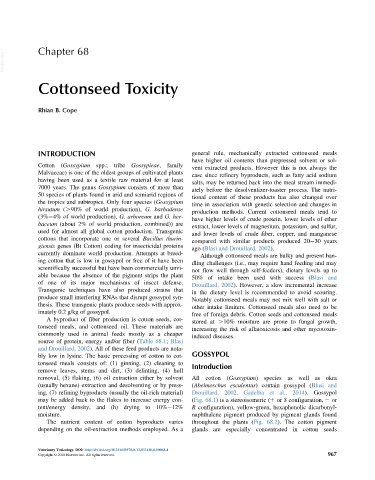Page 1035 - Veterinary Toxicology, Basic and Clinical Principles, 3rd Edition
P. 1035
VetBooks.ir Chapter 68
Cottonseed Toxicity
Rhian B. Cope
INTRODUCTION general rule, mechanically extracted cottonseed meals
have higher oil contents than prepressed solvent or sol-
Cotton (Gossypium spp.; tribe Gossypieae, family
vent extracted products. However this is not always the
Malvaceae) is one of the oldest groups of cultivated plants
case since refinery byproducts, such as fatty acid sodium
having been used as a textile raw material for at least
salts, may be returned back into the meal stream immedi-
7000 years. The genus Gossypium consists of more than
ately before the desolventizer-toaster process. The nutri-
50 species of plants found in arid and semiarid regions of
tional content of these products has also changed over
the tropics and subtropics. Only four species (Gossypium
time in association with genetic selection and changes in
hirsutum (.90% of world production), G. barbadense
production methods. Current cottonseed meals tend to
(3% 4% of world production), G. arboreum and G. her-
have higher levels of crude protein, lower levels of ether
baceum (about 2% of world production, combined)) are
extract, lower levels of magnesium, potassium, and sulfur,
used for almost all global cotton production. Transgenic
and lower levels of crude fiber, copper, and manganese
cottons that incorporate one or several Bacillus thurin-
compared with similar products produced 20 30 years
giensis genes (Bt Cotton) coding for insecticidal proteins
ago (Blasi and Drouillard, 2002).
currently dominate world production. Attempts at breed-
Although cottonseed meals are bulky and present han-
ing cotton that is low in gossypol or free of it have been
dling challenges (i.e., may require hand feeding and may
scientifically successful but have been commercially unvi-
not flow well through self-feeders), dietary levels up to
able because the absence of the pigment strips the plant
50% of intake been used with success (Blasi and
of one of its major mechanisms of insect defense.
Drouillard, 2002). However, a slow incremental increase
Transgenic techniques have also produced strains that
in the dietary level is recommended to avoid scouring.
produce small interfering RNAs that disrupt gossypol syn-
Notably cottonseed meals may not mix well with salt or
thesis. These transgenic plants produce seeds with approx-
other intake limiters. Cottonseed meals also need to be
imately 0.2 g/kg of gossypol.
free of foreign debris. Cotton seeds and cottonseed meals
A byproduct of fiber production is cotton seeds, cot-
stored at .10% moisture are prone to fungal growth,
tonseed meals, and cottonseed oil. These materials are
increasing the risk of aflatoxicosis and other mycotoxin-
commonly used in animal feeds mostly as a cheaper
induced diseases.
source of protein, energy and/or fiber (Table 68.1; Blasi
and Drouillard, 2002). All of these feed products are nota-
bly low in lysine. The basic processing of cotton to cot- GOSSYPOL
tonseed meals consists of: (1) ginning, (2) cleaning to Introduction
remove leaves, stems and dirt, (3) delinting, (4) hull
removal, (5) flaking, (6) oil extraction either by solvent All cotton (Gossypium) species as well as okra
(usually hexane) extraction and desolventing or by press- (Abelmoschus esculentus) contain gossypol (Blasi and
ing, (7) refining byproducts (usually the oil-rich material) Drouillard, 2002, Gadelha et al., 2014). Gossypol
may be added back to the flakes to increase energy con- (Fig. 68.1) is a stereoisomeric (1 or S configuration, 2 or
tent/energy density, and (h) drying to 10% 12% R configuration), yellow-green, hexaphenolic dicarbonyl-
moisture. naphthalene pigment produced by pigment glands found
The nutrient content of cotton byproducts varies throughout the plants (Fig. 68.2). The cotton pigment
depending on the oil-extraction methods employed. As a glands are especially concentrated in cotton seeds
Veterinary Toxicology. DOI: http://dx.doi.org/10.1016/B978-0-12-811410-0.00068-4
Copyright © 2018 Elsevier Inc. All rights reserved. 967

